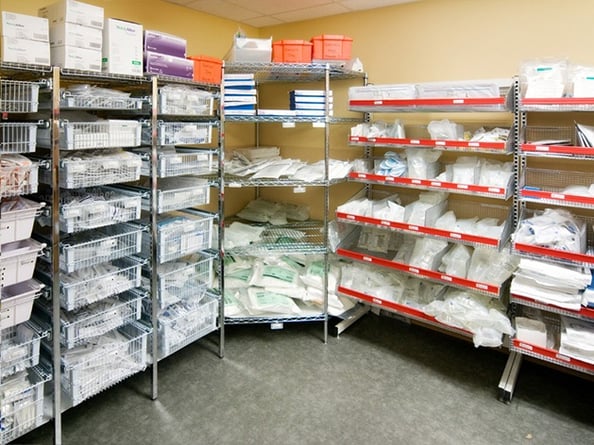
The dental industry is a massive, age-old industry. Yet, despite its many implements and instruments benefiting from impressive technological innovation over the past decade, its operational processes, most dental professionals will tell you, have remained “stuck in the stone age.”
Inventory management is one process high on the “outdated list”, and it’s the one we’ve dedicated the last year (or more, for some of us) to fixing. Here are some of our findings, and the key things we learned along the way.
Most practices rely primarily on paper, and expect predictable results from it.
“Paper is still better” may be a defensible claim when it comes to books, but certainly not when it comes to managing a dental practice. After conducting a survey, we found that 9/10 practices claimed to have “advanced systems”, yet relied primarily on paper processes for their inventory management.
By no means do we think dentists and their staffs believe paper is an advanced method of any sort. But such a statistic is, however, very pertinent, for two reasons. The first is that old tag systems or paper labeling processes heavily rely on human error, or lack thereof. As a new generation of dental professionals joins the industry, they will increasingly demand easier and more technologically simplified ways of doing things. The second reason, is that as baby boomers are transitioning out of owning their own practices, the question of “how much your dental inventory is worth”, becomes very important during evaluation of the practice.
When dentists don’t value time-savings enough, it affects the entire industry.
A good dental practice is like a well-oiled machine. But even an efficient practice wastes an average of 4-8 hours a month managing their inventory, according to our research - which amounts to up to 96 hours annually. When it comes to managing inventory, most solo practitioners have all but accepted the sad ‘reality’ that the standard will always be gravely low. To us, that is the sad reality.
What makes large, multi-location groups more efficient compared to solo practitioner practices is primarily time management. When a multi-location group saves even one hour of staff time on inventory management or other daily/recurring tasks, across 10, 20 or even 50 locations, it yields immediate and significant financial savings. Solo practitioners, on the other hand, have historically accepted the belief that “saving time is simply out of the realm of possibilities”, and that inefficiencies can only be solved by having assistants or office managers work longer, or “smarter”. This usually means manually sifting through multiple paper or web catalogs to find supplies at a lower cost - which itself can be incredibly time-consuming. Naturally, because the problem itself of inefficient time management is left unaddressed by solo practitioners, the demand for a better solution remains low, and the dental industry as a whole is delayed in its technological development.
When practices keep too much inventory on hand, they greatly limit their cash flow.
Many practices often claim that because their cash flow is so tight, they “don’t have the money” to invest in other “non-essentials” aspects of their business, like marketing or SEO, or even building a better website. But were they to determine the optimal amount of inventory their practice should have on-hand at any given time, most practices would discover that they are spending far more than what is necessary to meet their patient needs.
For example, after working with some of the most successful practices all over the Chicagoland area, we found that an average practice (1-3 offices, 6 chairs/office; general dentistry, with some specialty; e.g. Ortho and oral surgery) should have on hand during any given month is $30k - $32k worth of product. Yet we discovered that 5/10 offices were warehousing $45k or more - much of it for 3-6 months, or longer. That’s approximately $13k - $15k of unutilized cash flow that could be invested in other facets of business.
Bad product catalogs are a huge issue, for practices and distributors.
As we were building out our own digital product catalog for our clients, we discovered very quickly how difficult of a process finding just one product you’re looking for can be (we officially know how you feel now...). Naturally, it didn’t come as a surprise to us that this process of tediously sifting through catalogs is one of the most time-consuming steps of most practices’ inventory management.
Whether paper or digital catalogs, products often tend to be organized insensibly, page layouts are confusing and poorly labeled, and for many distributor websites, certain images fail to even display. But this isn’t just bad for dental professionals. It’s bad for distributors too. Throughout our time working with dental assistants from various practices, we encountered countless occasions when a given product could simply not be found (even from some of the industry’s top distributors). In response, most assistants we worked with would then call the appropriate local sales rep. These sales reps would often times, in turn, schedule an appointment to explain or sell other products, when all the practice wanted was to place an order for a product it needed, essentially “talking themselves out of sale.”
Product order errors are costing practices, and the industry as a whole.
When processing the invoices of newly acquired clients, we found that on average, practices were overpaying $15-25/month on wrong quantities or products, missing items, or “free goods.” And while this may not sound like a big number at first, it becomes staggering when put into reference of the entire industry. Given there are roughly 140,000 dental clinics in the U.S., approximately $2.5 million is wasted annually on order errors alone.
This may not be a pleasant truth, and we certainly don’t blame any one distributor for it, but it’s a reality nonetheless: the outdatedness of inventory processes is costing practices, distributors and the dental industry as a whole, dearly.
< Back to Blog

